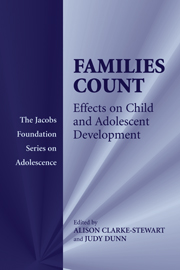Book contents
- Frontmatter
- Contents
- List of Contributors
- Introduction
- PART ONE RISK AND RESILIENCE
- PART TWO PEERS AND PARENTS
- 4 The Influence of Family and Peer Relationships in the Development of Competence during Adolescence
- 5 Toward a Dynamic Developmental Model of the Role of Parents and Peers in Early Onset Substance Use
- PART THREE WORK AND FAMILY
- PART FOUR DISCORD AND DIVORCE
- PART FIVE NEW AND EXTENDED FAMILY FORMS
- PART SIX CONCLUSIONS AND COMMENTARIES
- Index
- References
4 - The Influence of Family and Peer Relationships in the Development of Competence during Adolescence
Published online by Cambridge University Press: 05 June 2012
- Frontmatter
- Contents
- List of Contributors
- Introduction
- PART ONE RISK AND RESILIENCE
- PART TWO PEERS AND PARENTS
- 4 The Influence of Family and Peer Relationships in the Development of Competence during Adolescence
- 5 Toward a Dynamic Developmental Model of the Role of Parents and Peers in Early Onset Substance Use
- PART THREE WORK AND FAMILY
- PART FOUR DISCORD AND DIVORCE
- PART FIVE NEW AND EXTENDED FAMILY FORMS
- PART SIX CONCLUSIONS AND COMMENTARIES
- Index
- References
Summary
Adolescence has long been considered to “begin in biology and end in culture.” This phrase traditionally refers to well-known psychological and behavioral markers of adolescent development, such as increasing parent-child conflict and intensified orientation to peers, which reflect both biological maturation and social and cultural expectations. Until recently, specialists in adolescence had given little attention to questions about the contributions of genetic or environmental effects to individual variation. Research with adolescents did have in common with other periods, however, an emphasis on questions of whether interpersonal forces influence adolescent development and, if so, which ones are especially important. Consequently, research before the late 1980s typically begged the question posed for this chapter: “How do parents and peers contribute to adolescent behavior?” Like other recent writers (e.g., Collins, Maccoby, Steinberg, Hetherington et al., 2000; Goodnow, 1992; Maccoby, 2000; Rutter et al., 1997), we propose that questions of whether and which now should be supplemented by the study of how (by what processes) and when (under what conditions) influences come about in the interpersonal experiences of adolescents.
We argue that the content and quality of relationships with both family members and other significant companions determine the nature and extent of their impact on development. The chapter is divided into three sections. In the first section, we briefly describe recent research findings on normative relationship networks in adolescence.
- Type
- Chapter
- Information
- Families CountEffects on Child and Adolescent Development, pp. 79 - 103Publisher: Cambridge University PressPrint publication year: 2006
References
- 11
- Cited by

